Today, a wide variety of capacitors with a range of features are available, which can make it difficult for circuit designers and electrical engineers to determine the best fit for their application. To add to the confusion, there is somewhat of a misconception today that some capacitors, such as tantalum and Class II MLCCs, are interchangeable. But this is not always the case. Each capacitor type has distinct advantages and disadvantages that are important to understand to ensure you choose the right technology to best meet the needs of your specific application requirements. This post provides a brief overview of these two capacitor types as well as a variety of factors to consider when making your capacitor selection.
A Brief Overview of Tantalum and MLC Capacitors
A capacitor made using tantalum is a type of passive electrolytic capacitor. These capacitors consist of an anode, or positive plate, an oxide layer that acts as the capacitor’s dielectric, and a cathode, or negative plate. More specifically, tantalum capacitors use a porous tantalum metal shaped in a pellet as the anode, an oxide layer as the dielectric, and a manganese oxide layer as the cathode (Figure 1). Tantalum capacitors can come in radial, axial, and surface-mount (SM) form factors.
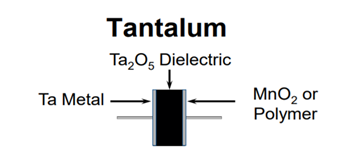 Figure 1. A diagram of the construction of a typical tantalum capacitor. Source.
Figure 1. A diagram of the construction of a typical tantalum capacitor. Source.
MLC capacitors are passive ceramic capacitors that use ceramic layers as the dielectric and thin metal layers as the electrodes (Figure 2). MLCCs can come in leaded and SM form factors and are mainly used for lower capacitance (pF - uF) applications. In general, MLCC’s are separated into the following two classes:
- Class I capacitors – High stability and low loss for resonant circuit applications
- Class II capacitors – Higher volumetric efficiency for bypass and coupling applications
Class II MLCCs are most comparable to tantalum capacitors since Class II MLCCs have a higher volumetric efficiency. Therefore, the remainder of the discussion in this post will focus on Class II MLCCs specifically.
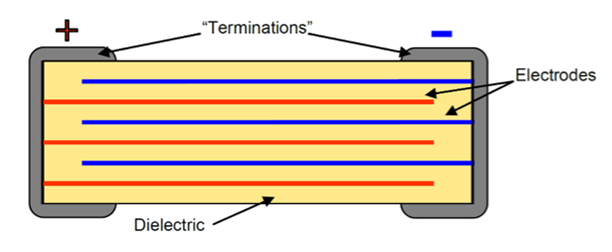
Figure 2. In Illustration of how an MLCC is constructed.
Now that we have gone through a basic overview of the difference in construction of these two capacitor types, let’s look at a variety of factors to consider when it comes to selecting which capacitor will be the best fit for your application.
Volumetric Efficiency and High Capacitance
Both tantalum and MLC capacitors have high volumetric efficiency, which means that given their size these capacitors can handle a high level of capacitance. However, one big benefit of tantalum capacitors is that these capacitors can handle capacitance values up to 1,000 µf, which is 10X greater than the maximum capacitance value of a Class II MLCC. This makes tantalum capacitors a good fit for applications that need quick bursts of high capacitance and charge in a small package such as medical implantable devices like defibrillators and pacemakers.
Equivalent Series Resistance and Frequency Range
Equivalent series resistance (ESR) is the internal resistance in the capacitor that appears in series with the capacitance of the device. At high frequencies, especially those 100 kHz or higher, Class II MLCCs have a much lower ESR than tantalum capacitors and will not overheat when used in high-frequency applications such as satellite communication equipment. Since tantalum capacitors have less resistance, less heat is dissipated, which means tantalum capacitors can overheat at high frequencies. At high frequencies, tantalum capacitors are less reliable and can experience excessive power loss and shortened battery life.
Additionally, since ESR increases impedance in circuits, tantalum capacitors are less effective for smoothing, filtering, and coupling applications at high frequencies compared to MLCCs. However, at low frequencies tantalum capacitors have a much lower ESR than MLCCs. Figure 3 illustrates the ESR of various capacitor types across a range of frequencies.
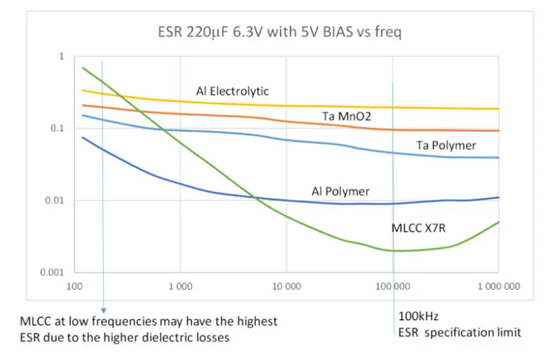 Figure 3. This graph represents how ESR changes for five different types of capacitors from low to high frequencies and shows that MLCCs exhibit the lowest ESR at the highest frequencies. Source.
Figure 3. This graph represents how ESR changes for five different types of capacitors from low to high frequencies and shows that MLCCs exhibit the lowest ESR at the highest frequencies. Source.
Temperature Stability, DC Bias Effects, and Aging
Generally, tantalum capacitors are temperature stable and experience minimal capacitance change linearly between operating temperatures. This makes tantalum capacitors a good fit for circuits operating at extremely high temperatures such as those used in downhole oil and gas operations that can approach nearly 125°C. In these extreme environments, capacitance will change much less using a tantalum capacitor than it would with a Class II MLCC. Also, DC bias voltage does not affect tantalum capacitors, while it does for Class II MLCC’s.
Additionally, with tantalum capacitors, capacitance will not decrease over time and there are not any mechanisms that can wear out as the capacitor ages. The dielectrics used in Class II MLCCs are ferroelectric, so permittivity will decrease over time causing capacitance to decrease. Additionally, Class II MLCCs are piezoelectric, which means MLCCs can vibrate in all directions due to voltage fluctuation, generating audible unwanted noises. Therefore, tantalum capacitors are a good fit for applications that require long-term stability, low noise, and high capacitance such as automotive applications.
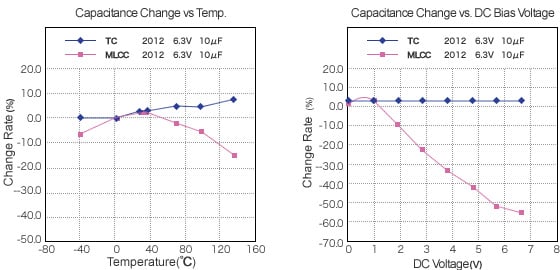
Figure 4. A summary of capacitance stability for tantalum and MLCCs as temperature and DC voltage change. Source.
Operating Voltage and Configuration
Class II MLCCs can safely operate up to 12kV while tantalum capacitors have a much lower voltage rating ranging from 4V to 50V depending on the size. Applying voltage higher than the rated voltage for a tantalum capacitor can result in catastrophic failure including combustion, fire, small explosions, and thermal runaways (Figure 5). Therefore, high-voltage applications such as power supplies, high-voltage output filters, and voltage multipliers need MLCCs rather than tantalum capacitors.
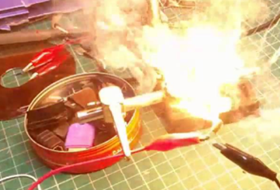 Figure 5. An example of a tantalum capacitor that caught on fire after being used beyond its safe operating limits. Source.
Figure 5. An example of a tantalum capacitor that caught on fire after being used beyond its safe operating limits. Source.
There is also a linear reduction in working voltage above 85°C, in tantalum capacitors. Therefore, manufacturers generally recommend the voltage of tantalum capacitors does not exceed 50 percent of its rated voltage if the maximum operating temperature is being used (Figure 6).
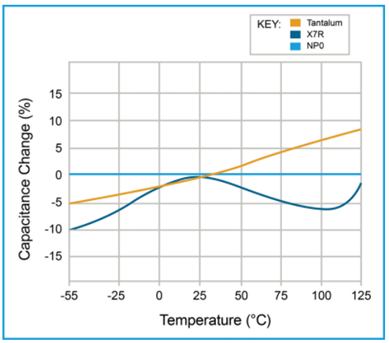 Figure 6. This graph shows the relationship between operating temperature and capacitance for tantalum and Class I and Class II MLCCs. Source.
Figure 6. This graph shows the relationship between operating temperature and capacitance for tantalum and Class I and Class II MLCCs. Source.
Additionally, MLCCs can be oriented in any way because there are two non-polarized sides soldered to a circuit board. As long as both terminations are connected to the circuit, it will work. On the other hand, tantalum capacitors are polarized, like a battery, which means these capacitors need to be oriented to the correct terminal to function properly. If this is not done correctly and the capacitor is subjected to high reverse polarity pulses, there is the potential for explosive failure modes.
So, Should I Use a Tantalum or Class II MLCC?
As shown, tantalum capacitors and MLCCs are not always interchangeable. If the only parameter needed for consideration is capacitance, then yes, MLCC’s can potentially match the lower capacitance levels of Tantalum capacitors. However, most high-reliability applications require consideration for more parameters than just capacitance. Tantalum capacitors can be an attractive option for applications that need high capacitance in a small footprint while also providing long-term stability. Likewise, Class II MLCCs are overall more reliable and therefore a good fit for applications that need to function reliably at high frequencies or high voltages.
Learn more about the variety of MLCCs, and other capacitors, offered by Knowles Precision Devices.

